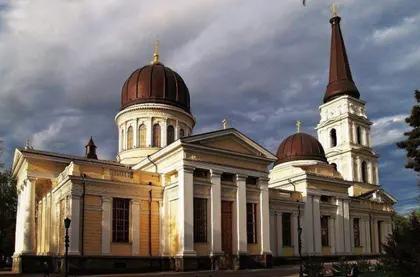Editor's Note: This article was originally published in January 2021 in The Odesa Journal. It is being republished today in light of Russia's overnight missile attack which has partially destroyed the building.
Odesa was founded in 1794 and the place for the construction of the Church of St. Nicholas the Wonderworker was chosen on the today’s Cathedral Square. On November 14, 1795, the first stone was laid by the Metropolitan Gabriel. This church became the progenitor of the future cathedral.
- Get the most recent war in ukraine update from the Kyiv Post's daily news reports for today.
- Check out the freshest Ukraine news items as of today.
JOIN US ON TELEGRAM
Follow our coverage of the war on the @Kyivpost_official.
The construction of the church, according to the plans of the engineer-captain Vanrezant and the architect Frapolli, was completed on May 25, 1808. The grand opening took place on May 25, 1809. The Archbishop Platon dedicated the church to the Transfiguration of the Saviour, since its main altar was consecrated in honour of the Transfiguration of the Lord (the other two thrones in honour of St. Nicholas and St. Spyridon).
In the first decades of its existence, the cathedral was small. No one could predict such a rapid growth of the City and its population. In the following years, the church underwent many changes: in 1837, a bell tower was erected. Its main bell was cast on the spot from 28 Turkish cannons: a trophy of the campaign of 1828-1829.
In the same year, Odesa became the seat of the Kherson-Tauride diocesan bishop and the church received the proud title of Cathedral. The new status required more space, therefore the cathedral began to expand. A refectory was added, connecting the bell tower and the old church. In 1894, a major overhaul was carried out in the cathedral, and 6 years later, a global reconstruction brought the facades to a single style. Two side domes and a portico were built at the Eastern facade. The floors were covered with marble tiles and new chandeliers were especially made.

INTERVIEW: Aussie, Banker, Soldier, Volunteer – Living the Dream in Odesa
From the infancy of Odesa, the Spaso-Preobrazhensky Cathedral was a place closely connected with any significant events of its social and spiritual life. All holidays began there, both church and secular, and there the citizens came in the most difficult times, like during the bombing of the city by the British fleet in 1854, during the war of Crimea.
The special role of the cathedral in the spiritual life of Odesa and the region was determined by the highly venerated relics kept there: the Kasperovskaya miraculous icon, the ancient image of Nikolai Mirlikisky, the "Trinity" by the famous painter Paul Leroy, copies of ancient icons of korsuns, a copper cross cast from coins donated by privates of the Crimean War, a captured Turkish banner, bestowed by the Emperor.
The cathedral also contains the remains of the Governor-General Prince M.S. Vorontsov and his wife Elizabeth. After the plundering of the temple, in the Thirties, the remains were transferred to the Slobodskoye cemetery, but in 2005, the Vorontsovs were reburied in the cathedral.
The destruction of the Cathedral
In 1932, the Cathedral was closed, as part of the fight against religion further the Bolshevik revolution. The new government confiscated all its furnishings. They even took out marble, tearing it off the floor and walls.
In 1936, the cathedral was destroyed. According to one version, it was blown up, according to another, it was dismantled almost by hand, stone by stone.
In the place of the old church they erected a "Stalin Memorial", which covered the entire western part of the cathedral square with concrete armour. Foundations and basement floors of the temple were hidden from the inhabitants of Odesa.
The rebuilding
But after the fall of Soviet Union, the Odessites started talking about the possibility of reconstructing their most important religious monument. Many volunteers organised a fund raising for the reconstruction of the Odesa Transfiguration Cathedral.
This initiative found the endorsement of the mayor's office, which encouraged private local companies’ donations for the reconstruction. The City Council approved a document on the procedure for conducting special research and design and survey work to revive the cathedral.
Since 1999, the charitable organization "Black Sea Orthodox Fund" collected from both entrepreneurs and ordinary citizens (even foreigners) a little more than 615 million dollars for the rebuilding of the temple.
The restored Spaso-Preobrazhensky Cathedral was consecrated on July 21, 2010 by the Patriarch Kirill of Moscow and All Russia. Moreover, the Cathedral received a gift from Greece: 23 bells for the renovated belfry, which is the largest bell tower in Ukraine.
The mystery of the Filatov’s fountain
The fountain on Cathedral Square is the most famous fountain in the city. Around it, chess lovers gather and artists sell their works and old people take a break from the sweltering summer heat. But, Odessites also call the fountain of the Cathedral with another name: “Filatov's Vase”.
Soviet city bosses, in order to demonstrate their own zeal in the fight against the "opium for the people", wanted to install a public toilet on the site of the destroyed cathedral, approximately at the place where the altar was located. Many citizens were justly outraged by this, but only Vladimir Petrovich Filatov, a world famous academician ophthalmologist, risked personally opposing the blasphemous project.
By his own money, he bought a stone vase in the shape of a flower and decorated the fountain with it. The water sprays of the fountain, sparkling with all the colours of the rainbow, delighted the inhabitants of Odesa. Thanks to Filatov, who was respected by many representatives of the Soviet Odesa and Ukrainian authorities, for several decades a public toilet did not debunk the Cathedral Square.
Actually, there were 2 fountains of historical value on the Square. The first, located closer to Preobrazhenskaya Street, was built in 1873, simultaneously with the Odesa water supply system, and it was the first fountain where the Dniester water arrived. The second one, on the site of the destroyed altar of the Odesa Cathedral of the Transfiguration of the Saviour, was Filatov’s one.
In the early 2000s, when it was decided to restore the Transfiguration Cathedral, Filatov's fountain had to be demolished. The flower vase was transferred to the old fountain closer to Preobrazhenskaya Street. The inhabitants of Odesa still call it "Filatov's Vase".
You can also highlight the text and press Ctrl + Enter










